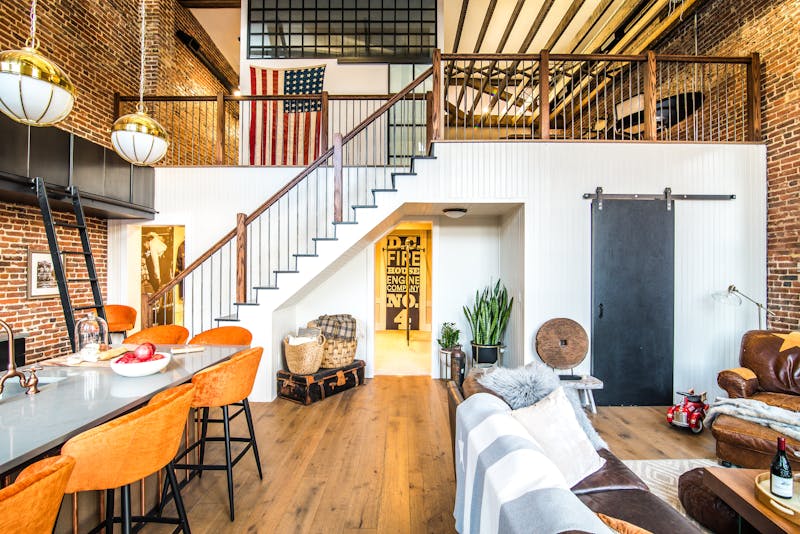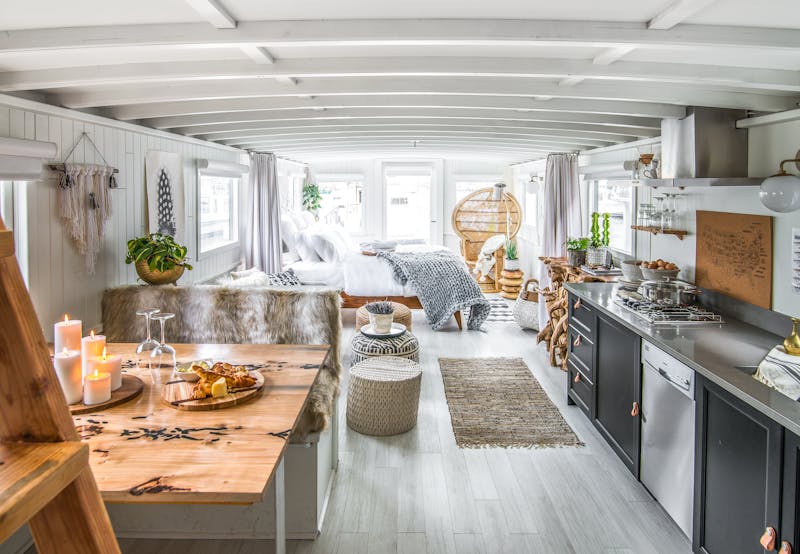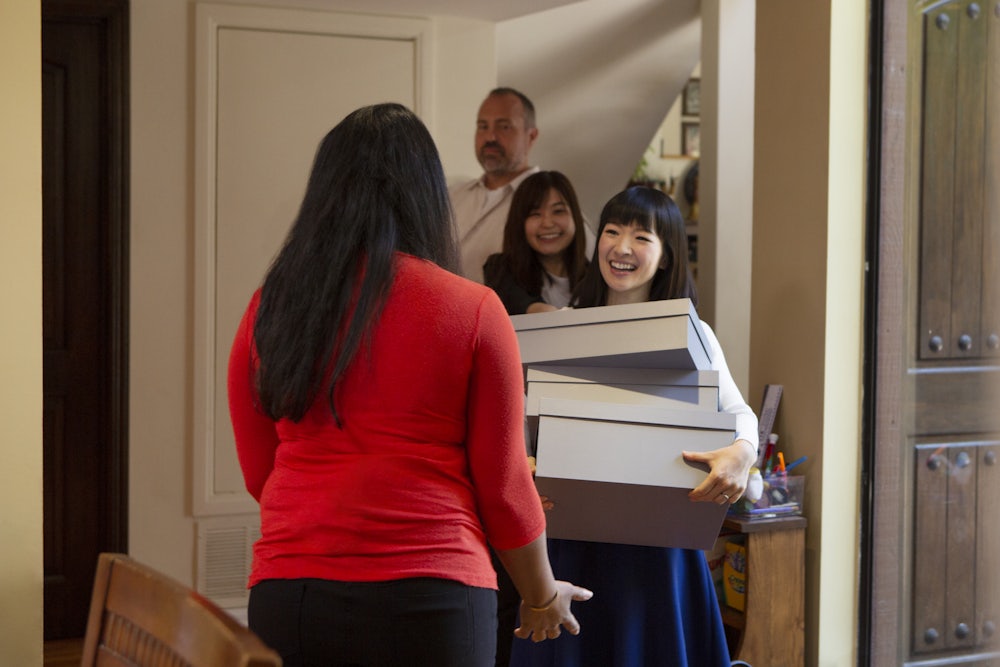The coupled protagonists of Georges Perec’s materialist parable Things, Jerome and Sylvie, are 24 and 22 years old, both conductors of marketing interviews. Their dearest dream is to live in a Parisian apartment with a successfully bourgeois interior—charmingly untidy with floor-to-ceiling cabinetry, worn black leather sofa, roll-top desk—while in reality they inhabit a tiny, low-ceilinged space that they can’t bring themselves to do anything about. “They would have liked to give themselves to something, to feel in themselves some powerful need that they would have called a vocation,” Perec wrote. “But they possessed, alas, but a single passion, the passion for a higher standard of living, and it exhausted them.”
Jerome and Sylvie would have made perfect participants for a slew of new reality television shows focused chiefly on the anxieties of domestic space in late capitalism, when our identities are even more wrapped up in our possessions and the quality of rooms than when Perec wrote his story in 1965. Our rented apartments in gentrifying urban neighborhoods must be evacuated of old possessions, repopulated with upscale generic start-up furniture, and then temporarily sublet to pay the rising rent. It’s exhausting.
In Tidying Up, the pixieish Japanese cleaning celebrity Marie Kondo might help you find new organizational strategies while breaking your dependence on all the junk that doesn’t “spark joy.” The Australian Instant Hotel and British Stay Here both turn Airbnb into a competitive art form. The latter sees a pair of designers renovate participants’ properties into ideal listings for the platform while the former sets loose a raucous group of Australian couples who all stay in and evaluate each other’s home rentals. Like HGTV without the concept of total home ownership, the shows betray the fact that our domestic spaces are less our own than ever. Instead of homes, we live in commodities.
Marie Kondo’s two books, The Life-Changing Magic of Tidying Up (published in the United States in 2014) and sequel Spark Joy (2016), have sold many millions of copies all over the world. Kondo signed her first book deal after taking a course in Tokyo, titled “How to write bestsellers that will be loved for ten years,” which she did. The books rely less on specific content than their simple framework and the undeniable magnetism of their author. The instructions Kondo gives are, roughly: Stack all your stuff into massive piles; evaluate one by one whether your items spark joy; throw out anything that doesn’t, and organize the rest. Fold it in thirds, organize it so you can see it all at once, and store it in open boxes, which get put inside other boxes (Kondo now sells her own boxes for $89).
In the Netflix show,
fittingly released on the cusp of a new year, Kondo acts as a kind of traveling
doctor, visiting California homes alongside her translator in order to put
occupants through her trademark KonMari Method. She is trim and bright,
outfitted in antiseptic white tops, with a wide smile optimistic enough to
irradiate clutter—an emissary from a better, cleaner universe. “The goal is to
cherish everything that you have so you can achieve happiness for your family,
so you can live comfortably,” she says. The enemy is mess, which Kondo
professes to love in a kind of Freudian way. Her eyes light up when she sees
her new clients’ overflowing closets and impenetrable spare bedrooms.
The show is more
interesting for its unveiling of couple and family dynamics than it is for any
clear instruction in the art of tidiness. In its first (and best) episode, Rachel
and Kevin Friend, a hip-looking young couple with two toddlers, confront the
excess in their Lakewood house. Deeper issues quickly emerge. “I want to
appreciate what I have instead of needing more things,” Rachel admits,
suffering the inherent trauma of capitalism. Kevin is annoyed that Rachel
refuses to do laundry. “I hope that this will get out of the way the things
that are keeping us from enjoying each other,” he says. “Couples can deepen
their ties through tidying,” Kondo observes. Indeed, the cleaning ordeal brings
the pair together. Getting rid of the kids’ overflowing clothes makes it easier
for Rachel to get them dressed, and the lack of mess helps Kevin grit his teeth
slightly less and be a “good dad” when he gets home from work.
The show’s intimacy lends it a YouTube-ish authenticity: Its subjects actually film themselves over the month-long process and the phone footage is interspersed with camera-crew work. Yet as soon as I recognized the episode structure, I wanted to fast-forward to the inevitable tears. Men who realize they have to give up their sneaker or baseball-card collections. The woman who admits to retail therapy as a form of revenge. The widow who has to sort through her late husband’s shirts in order to take up a new life of traveling and create a craft room in her plush McMansion. More than a clean house, Kondo gives her subjects a new sense of themselves.
Unlike, say, HGTV’s Fixer Upper in which we see reinvented structures, there isn’t much of a satisfying reveal at the climax of these episodes. Clothes have been folded, kitchen appliances aligned, and books jettisoned, causing consternation among literary watchers. (Kondo gives a lesson relevant to the fake news era: “Books are the reflection of our thoughts and values, so by tidying books it will show you what kind of information is important to you at this moment.”) The subjects are generally enthused at their new, joy-sparked lives, but it is a minimalist process of refinement rather than renovation. Progress is abstract, which is one reason the episodes could have been half as long.
The commandment to think carefully about what you own isn’t so radical, after all. “Sparking joy” still relies on material goods to form the basis of an identity: Each object must feel like it is an ineffable part of you, as if your old T-shirts emitted a Benjaminian aura. It’s not about taking up meditation or therapy; Kondo is advocating for something as close to perfect consumption as possible. The idea that things don’t matter is anathema to KonMari.
If Kondo wants you to throw out everything that doesn’t feel personal, then Instant Hotel and Stay Here emphasize getting rid of personal effects in order to make the domestic space as generic as possible, the better to profitably enter it into the sharing economy, in which strangers will have to feel like it is their home as well.
Stay Here, another Netflix original production, is the highest-budget and most fun of the group in a hate-watch, eat-the-rich kind of way—it could be used for DSA radicalization sessions. Its tagline is “Makeover. Make money.” HGTV star Genevieve Gorder, a charming designer, and Peter Lorimer, a slick British music producer turned celebrity realtor, take properties that are being rented on Airbnb or the more luxe platform VRBO and renovate them so that they are better short-term rentals: the best Airbnb they can be.

Their chief goals are to raise the nightly rental price and occupancy rates. They crunch the numbers on-screen, reassuring the property owners that they will recoup all their mortgage and maintenance expenses plus a tidy profit. They achieve this by bringing in faux-mid century furniture, building out the same open kitchen you see in every new condo development, and adding a “social media moment,” some Instagrammable object or mural wall that will prompt guests to do your marketing for you. In Austin, it’s a geometric pattern painted on the poolhouse; in Palm Springs, it’s a period-piece 1970s room covered in pink upholstery. Gorder is ecstatic.
Let us consider the case of one gentleman who bought a disused firehouse in Washington, D.C., and turned it into his own apartment as well as an Airbnb. He lived in the huge loft space behind two floor-to-ceiling arched windows and rented out the darkened caverns in the rest of the building, which were filled with furniture barely worthy of a frat house. Gorder and Lorimer obviously kicked him out of the nice part of the house—you have to prioritize the guests—and opened the bright loft to the rest of the space.
It turns out that the firehouse was the first African-American firehouse in the city, opened because black firemen were having trouble getting promoted by racist white officers. Instead of, say, turning some part of it into a public space, Gorder fetishizes its heritage with bunk beds made of fire-poles and a vintage photo mural of the garage in its active days. “Now you can sleep in a piece of history!” Thus authenticity is commodified as #DCfirehouse4, $850 a night. Also not mentioned is the threat of gentrification that families of wealthy tourists pose to the historically African-American neighborhood.
In Stay Here, we might observe certain rules for an optimized Airbnb. You need to have as many bedrooms as possible, because “heads in beds” make money. Don’t think of it as a home; “you have to think like the GM of a small hotel,” bringing a strong business plan. Key to the process is what Gorder persists in calling “depersonalization”: removing any artifacts like family photos or mementos so that guests won’t feel like they’re in someone else’s life. Depersonalization also happens to be the clinical term for a psychological disorder in which you feel detached from yourself, like a robot. It seems apt. The Stay Here thesis is not that by remaking your house you might be happier; it is that you will be wealthier. “I’m going to crush my competition,” a man in Austin enthuses in a fit of post-renovation real estate Darwinism.

Homes were not competition until sharing-economy platforms gamified them with revenue charts and star ratings. Instant Hotel gamifies the gamification. The show originally aired in Australia in 2017 before Netflix picked it up. Two sessions of five Australian couples who have turned their houses into rental properties (“instant hotels”) go on a kind of national road trip, staying together at every other couple’s rental and then evaluating it, often viciously, like a mobile Big Brother. The categories are Design, Location & Attractions, Night’s Sleep, and Value; grand prize is a trip to California to stay in a famous Airbnb that might belong to a celebrity.
Personality is the problem. One couple is derided for their collection of 1950s American kitsch, another for their profusion of fake flowers, still another for the shower in the master bathroom with a full-length window you can’t block. When your home is a commodity, nothing unique or quirky is allowed. The winner of the entire competition is a “Zen” retreat that looks as inoffensive as humanly possible. Yet the show’s only appealing element is personality. It’s fun to watch for Australianisms. The group goes to a rural pub, races cane toads, and spears mud crabs. It did not make me want to travel there.
Maybe the issue is that these shows are too relevant, hovering on the border of entertainment and twenty-first-century economic survivalism. Years after its peak, Kondo-ing once again took over the Internet in the past week as viewers posted photos of their socks neatly aligned in drawers. I wondered if anything I owned truly sparked joy. Then again, if I suddenly couldn’t afford my rent, I could just ditch everything with a whiff of personality, then install bunk beds, pendant lights, and an Instagram wall with a hashtag decal and let my apartment monetize itself, right?
What these reality shows really point to is the need for rent control and tenants’ rights, a world in which we don’t have to repackage our homes in order to keep them. I propose outlawing private property and giving everyone 365 Airbnb credits a year instead.
Perec’s Jerome and Sylvie never find their way out of materialism either, despite abandoning Paris briefly for Tunisia. They return to France and find executive advertising jobs with salaries better suited to their tastes. “They will have their chesterfield settee,” Perec writes. “They will have huge and empty rooms full of light; plenty of clearance, glass panels, magnificent outlook.” Sounds nice, I’d stay there.
